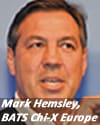BATS Chi-X Europe intends to set a new benchmark for market data pricing in Europe, after unveiling plans to become the first multilateral trading facility to charge for its data.
From 1 October 2012, members that receive pan-European data directly from BATS Chi-X Europe, will be charged between £50 and £4,000 for level one data and between £125 and £8,000 for level two data, depending on the number of internal end-users. Each user that receives the firm’s data from vendor terminals such as those provided by Thomson Reuters or Bloomberg will be charged £20 for level one data and £45 for level two data.
Trading participants receiving the data directly from BATS Chi-X Europe via vendor terminals will only be charged once.
Non-display data fees, i.e. market data used to underpin automated trading tools such as algorithms, for all markets will be charged at £1,500 (or £500 per market), while annual distribution licence fees will be levied at £15,000 for real-time level one data and £30,000 for real-time level one and level two data.
The cost of market data is seen as a major obstacle to the creation of a post-trade consolidated tape.
“Our customers definitely view market data costs as too expensive. We have set out an aggressive strategy to establish a benchmark for market data charges in Europe and hope that our tariffs will help to stimulate debate in this area,” Mark Hemsley, CEO of BATS Chi-X Europe, told theTRADEnews.com.
BATS has said its market data charges are a tenth of the aggregated fees charged by all the major domestic markets it covers.
“It is now up to the industry to push the debate further with what we think is a good quality reference point,” said Hemsley. “Given our market share and the investment that we have put into the company, we and the majority of our clients think that its fair we charge for data.”
Despite facing the prospect of paying for yet more data, market participants are hopeful that the MTF’s tariff will have a meaningful impact on exchange data fees.
“BATS Chi-X Europe’s data fees were inevitable, but they are not unreasonable,” said Kee-Meng Tan, managing director and head of agency broker Knight Capital’s trading group in Europe. “We mainly hope it will shine a light on the disparities between exchanges and alternative venues when it comes to data fees. Exchanges continue to raise charges for their data, despite the declining share of continuous trading they account for. This is enabled by the fact that they continue to monopolise opening and closing auctions facilitated by their ownership of index licenses.”
Trade body the Federation of European Securities Exchanges has attempted to facilitate the creation of a consolidated tape with a series of commitments from its national exchange members to improve European market data. This included making data free to the public and end-users after 15 minutes, unbundling pre- and post-trade data to enable easier consolidation and harmonisation of the tags used by exchanges to identify trade tyes.
BATS Chi-X Europe, which operates two displayed and two dark order books, accounted for 23.6% pan-European market share in April according to data from Thomson Reuters Equity Market Share Reporter. The second biggest European market was Deutsche Börse, which had a market share of 13.2%, followed by the London Stock Exchange with 11.8%.
In its October draft of MiFID II, the European Commission favoured a commercial approach to the creation of a consolidated tape, whereby providers develop offerings inline with pre-defined and supervised standards. Consolidators would be required to aggregate data from newly-created entities known as approved publication arrangements that will have responsibility for ensuring data is of a sufficient standard.
